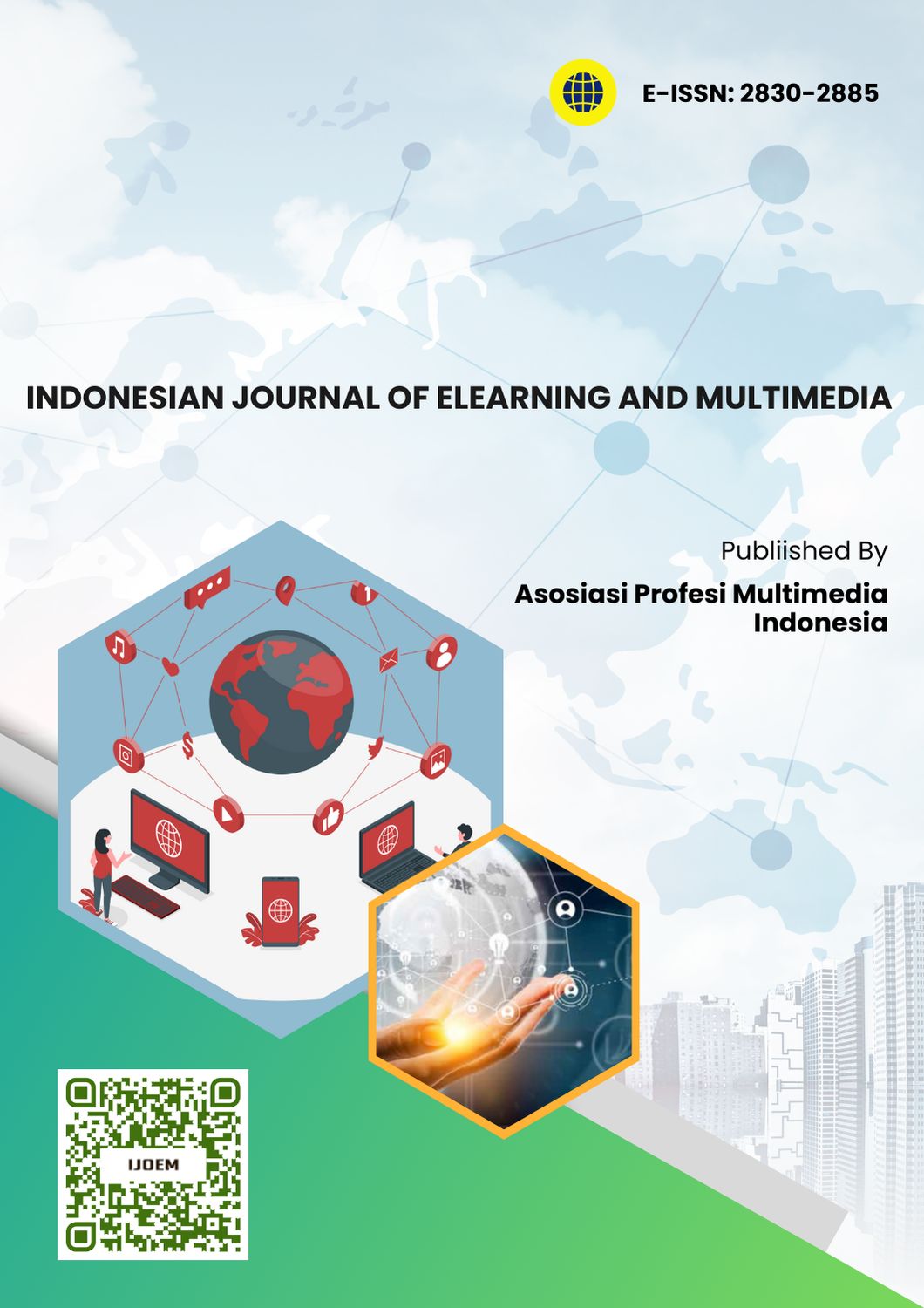Designing UI and UX Design in GenApp Application Using Design Thinking Method
Main Article Content
Abstract
This research aims to create an ARBook learning application design for high school students on genetic material. Today's growing technology has affected various fields, one of which is education. Generation Z is a generation that understands and is literate in technology. High school students born in Generation Z have characteristics that tend to like technology, are smart, open, and like to express themselves. To attract students' interest in learning, there needs to be media used by utilizing technology. It is necessary to understand the characteristics of students when making learning media design. The method used in this research is the design thinking method, which has five stages: emphasize, define, ideate, prototype, and test. This research produces an ARBook GenApp application design that suits the characteristics of Generation Z students. The test results from the student response trial obtained good results of 89.17%, which were included in the very feasible criteria.
Downloads
Article Details
Copyright (c) 2024 Rifda Falsa Salsabila, Ayung Candra Padmasari

This work is licensed under a Creative Commons Attribution-ShareAlike 4.0 International License.
References
Alam, N., Ariani, F., & Rizal, K. (2023). Penggunaan Metode Design Thinking untuk Perancangan UI/UX Aplikasi Rainbow Kids. Indonesian Journal Computer Science, 2(1), 16–21. https://doi.org/10.31294/ijcs.v2i1.1890
Alsaadi, H., Wali, A., & Fakieh, B. (2024). A dataset analysis of digital marketing ʼ s influence on purchase intentions of millennials and generation Z in Saudi Arabia. Data in Brief, 57, 111045. https://doi.org/10.1016/j.dib.2024.111045
Assaufa, N. I., & Arifin, M. (2023). Perancangan UI/UX Aplikasi “BISA” Dengan Pendekatan Design Thinking. Jurnal Ilmiah IT CIDA, 9(2), 50. https://doi.org/10.55635/jic.v9i2.174
Babu, M. A., Yusif, K. M., Eni, L. N., & Jaman, S. M. S. (2024). ChatGPT and Generation ‘Z’: A Study on the Usage Rates of ChatGPT. Social Sciences & Humanities Open, 10(October), 101163. https://doi.org/10.1016/j.ssaho.2024.101163
Bermúdez, K., & Caro, K. (2023). Computers & education : x reality effect of an augmented reality app on academic achievement , motivation , and technology acceptance of university students of a chemistry course. 2(April), 1–9. https://doi.org/10.1016/j.cexr.2023.100022
Chu, V. (2015). Pembuatan aplikasi pembelajaran genetika bagi siswa SMP kelas IX. Jurnal Ilmiah Mahasiswa Universitas Surabaya, 4(1), 1–9. Google Scholar
Dopades, M., Sumarlin, R., & Deanda, T. R. (2023). Analisis Ui Dan Ux Aplikasi Halodoc Terhadap Pengguna Layanan Kesehatan. Desain Komunikasi Visual Manajemen Desain dan Periklanan (Demandia), 8(1), 1-20. https://doi.org/10.25124/demandia.v8i1.4685
Dumalang, J. M., Montolalu, C. E. J. ., & Lapihu, D. (2023). Perancangan UI/UX Aplikasi Penjualan Makanan berbasis Mobile pada UMKM di Kota Manado menggunakan metode Design Thinking. Jurnal Ilmiah Informatika dan Ilmu Komputer (JIMA-ILKOM), 2(2), 41–52. https://doi.org/10.58602/jima-ilkom.v2i2.19
Effendi, D., & Wahidy, A. (2019). Pemanfaatan teknologi dalam proses pembelajaran menuju pembelajaran abad 21. Prosiding Seminar Nasional Pendidikan Program Pascasarjana Universitas Pgri Palembang, 125–129. Google Scholar
Faudzi, M. A., Cob, Z. C., Ghazali, M., Omar, R., & Sharudin, S. A. (2024). User Interface Design in Mobile Learning Applications: Developing and Evaluating a Questionnaire for Measuring Learners’ Extraneous Cognitive Load. Heliyon, 10(18), e37494. https://doi.org/10.1016/j.heliyon.2024.e37494
Golomingi, R., Dobay, A., Franckenberg, S., Ebert, L., & Sieberth, T. (2023). Augmented reality in forensics and forensic medicine – current status and future prospects. Science and Justice, 63(4), 451–455. https://doi.org/10.1016/j.scijus.2023.04.009
Hidayat, T., & Kasmiruddin. (2020). Miskonsepsi materi genetika tentang ekspresi gen. BIOEDUSAINS: Jurnal Pendidikan Biologi dan Sains, 3(1), 59–65. Google Scholar
Kasri, M. A., Novan, Y., & Ramadhani, I. A. (2021). Penerapan Model Design Thinking pada Pengembangan Media Pembelajaran Berbasis Macro Media Flash. JURNAL PETISI (Pendidikan Teknologi Informasi), 2(2), 60–71. https://doi.org/10.36232/jurnalpetisi.v2i2.1531
Latif, J. J. K., Triputra, A. A., Kesuma, M. A., & Maulana, F. I. (2023). Design and Development a Virtual Planetarium Learning Media Using Augmented Reality. Procedia Computer Science, 227, 726–733. https://doi.org/10.1016/j.procs.2023.10.577
Ma’arief, S. Y., Yudhapurnomo, A. P., Fatimah, S., & Wiharifin, R. F. (2021). Implementasi Prototipe Sila (Social Media Self Development Indonesia) dalam Design Thinking Digital Product Development. RESEARCH : Journal of Computer, Information System & Technology Management, 4(2), 109. https://doi.org/10.25273/research.v4i2.9938
Nurhayati, N., Pitoweas, B., Putri, D. S., & Yanzi, H. (2020). Analisis Kepekaan Sosial Generasi (Z) Di Era Digital Dalam Menyikapi Masalah Sosial. Bhineka Tunggal Ika: Kajian Teori dan Praktik Pendidikan PKn, 7(1), 17–23. https://doi.org/10.36706/jbti.v7i1.11415
Prismanata, Y., & Sari, D. T. (2022). Formulasi Media Pembelajaran untuk Peserta Didik Generasi Z dan Generasi Alfapada Era Society 5.0. Proceeding of Integrative Science Education Seminar, 2(April 2011), 44–58. Google Scholar
Raschintasofi, M., & Yani, H. (2023). Perancangan UI/UX Aplikasi Learning Management System Menggunakan Metode Design Thinking. Jurnal Manajemen Teknologi Dan Sistem Informasi (JMS), 3(1), 343–353. https://doi.org/10.33998/jms.2023.3.1.753
Sugiyono. (2018). Metode Penelitian Manajemen. ALFABETA.
Widodo, A., & Utomo, A. B. (2021). Media pembelajaran taksonomi hewan berbasis augmented reality dengan fitur multi target. Edu Komputika Journal, 8(1), 1–8. https://doi.org/10.15294/edukomputika.v8i1.40611
Y, E. (2020). Suatu Pengantar: Metode dan Riset Desain Komunikasi Visual DKV. Deepublish Publisher.
Yasa, I. W. A. P., Anggara, I. G. A. S., Pandawana, I. D. G. A., & Jayanegara, I. N. (2022). Flat Design Sebagai Gaya Visual Asset Game “Attack of the Krona.” Jurnal Bahasa Rupa, 5(2), 219–226. Google Scholar
Yudhanto, Y., Pratisto, E. H., Purnomo, F. A., Hidayat, T. N., Haqimi, N. A., & Ardhi, O. D. W. (2024). Design and Development Museum Ticketing System (MTS) with Design Thinking Method. Procedia Computer Science, 234(2023), 1212–1219. https://doi.org/10.1016/j.procs.2024.03.117



 Rifda Falsa Salsabila
Rifda Falsa Salsabila
